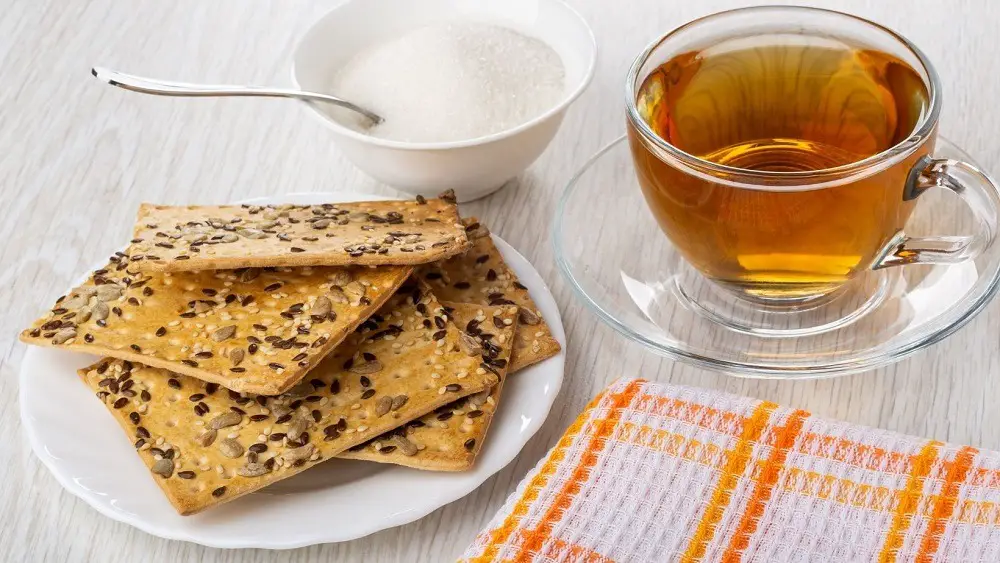Flaxseeds are also sometimes referred to as linseeds. They are small, oil-laden seeds native to the Middle East. They are incredibly popular as a health food and can also be used in vegan baking as an egg replacement.
Flaxseeds can be bought in their whole, roasted, or milled (ground) forms. You can also purchase flaxseed oil. They are either brown or yellow and are purported to have a huge number of health benefits.

If tea is not your first choice for warm drinks, do not despair. You can also add the flaxseed liquid to coffee for a healthy and caffeine-loaded start to your day.
What are the health benefits of flaxseed?
The nutrient breakdown of flaxseeds is approximately 42% fat, 29% carbs, and 18% protein. The majority of the carbohydrate content comes from indigestible fiber, making flax seeds a low-carb food source. You will get around 6 grams of fiber from just 2 tablespoons of flaxseeds. This equates to around 15% RDA for men or 25% RDA for women.
This fiber is a combination of both soluble and insoluble sources. Soluble fiber can regulate your cholesterol and blood sugar levels while assisting with the maintenance of beneficial bacteria in your stomach.
These are known as mucilage gums and they are found on the outside of the seed coating. These are what cause the water of the flaxseed tea to thicken slightly. Insoluble fiber is primarily used to maintain a healthy and functional digestive system.
The fiber content can also be used to relieve constipation as it helps to soften your stools and move things along the digestive tract. This will also help to alleviate bloating and can be used as a weight-loss aid.
The gloopy consistency of the tea is what makes it so intensely hydrating. The texture helps to relax your colon, allowing it to absorb a higher quantity of water. This can help to rehydrate you very effectively as the water will take longer to progress through your digestive system. This will have a multitude of positive health benefits including improving your skin quality.
Flaxseeds contain a lot of ALA (alpha-linolenic acid), an omega-3 polyunsaturated fatty acid. This is found in the highest concentration in flaxseed oil, and then milled flaxseeds. This is believed to help lower the risk of chronic diseases. It has been shown to reduce the number of cholesterol deposits in your arteries. This means that your risk of developing strokes is reduced.
There are many compounds known as lignans in flaxseeds, which are phytoestrogens. These are plant compounds that are biologically similar to human estrogen. They can help to lower your chances of developing heart diseases and metabolic issues.
This is because they control blood fat and glucose levels. They can also help to reduce your blood pressure and arterial inflammation. They have also been linked to a decreased risk of breast, skin, and colon cancer.
Flax Seeds are high in B-complex vitamins. These are particularly important for those who follow a vegetarian or vegan diet, as these can often be lacking. This group of vitamins can also help your hair grow faster and maintain a healthy and strong condition.
Flax Seeds are also high in vitamin E. This reduces the impact of harmful free radicals on your body, specifically on your scalp. This can further help to promote new hair growth.
What do you need to make flaxseed tea?
1 teaspoon flax seeds (whole or ground)
4 cups water
A flavored tea bag – we love peppermint or lemon and ginger tea#
Honey or another liquid sweetener (optional)
How do you make flaxseed tea?
Making flaxseed tea is incredibly simple. Place your flaxseeds and water in a saucepan and put this on your stovetop.
Bring the contents of your pan to a boil before reducing the heat. Allow the mixture to simmer for 20 minutes.
Cover the saucepan with a lid and allow the mixture to sit there for at least 12 hours. In the morning, strain your liquid through a sieve or cheesecloth. This will remove all of the seeds from the liquid. Do not dispose of the solids, you can use them as a flavorful addition to soups or bread dough.
Your strained liquid will be more viscous than just water and may appear to have a slightly gummy texture.
To make the tea for consumption, make a pot of tea as you usually would. Add a little liquid sweetener to the bottom of your cup, adjusting the quantity to suit your personal taste.
Add the flaxseed tea to your mug until it is around half full. Top with the fresh, hot tea that you have made and stir well to combine.
If this sounds like too much hassle for you, there are also flaxseed tea bags available online. These, from Tea Chupa Panza, available on Amazon will be ready in under 5 minutes.
Are there any dangers associated with flaxseeds?
As with any substance, there is the potential for an allergic reaction to consumption. This is very uncommon and is highly unlikely to occur.
There are compounds known as cyanogenic glycosides found in flaxseeds. In your body, these can combine with sulfur to create a new substance, thiocyanates. These can reduce the working of your thyroid gland if they are allowed to build to high levels.
This means that if you are known to have issues with your thyroid, you should be careful with your consumption of flaxseeds. It is a good idea to consult with your doctor before altering your diet. Generally speaking, the consensus is that up to 50 grams, or 5 tablespoons, of flax seeds, daily is healthy and beneficial to most individuals.
If you are anemic then you should also take care when consuming flaxseeds. There is a compound in them known as phytic acid. This can reduce your body’s absorption of zinc and iron. This is not often an issue but if your body already struggles to maintain adequate iron levels you should be careful.
